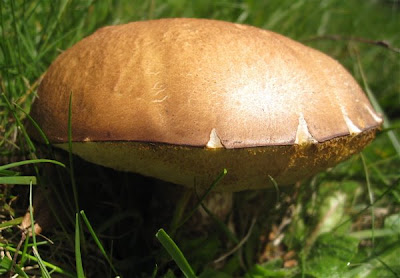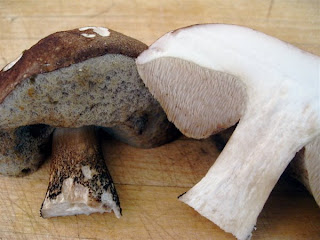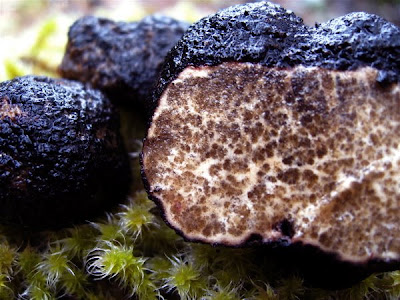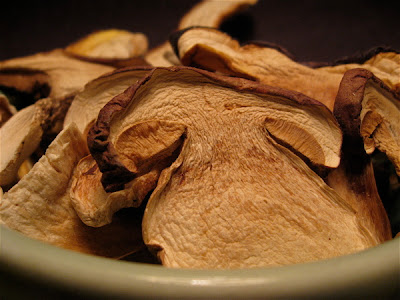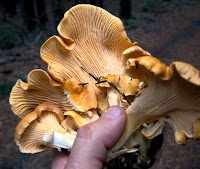Recently I picked up a used first edition of Jane Grigson‘s The Mushroom Feast to give me ideas for my large store of wild foraged mushrooms. The book is as much a feast for the eyes and mind as a cookbook, with tasteful line drawings and Grigson’s signature authoritative prose. In fact, I’ve been so in awe of the book that I haven’t cooked a single dish out of it—until last night. My choice: Boeuf a la Bourguignonne, to which I made a couple adjustments, including the addition of dried and reconstituted wild porcini (king boletes) and the substitution of sauteed chanterelles for champignons.
Admittedly, it’s not an easy first recipe to tackle. Beef Burgundy (in the English spelling) is beyond classic; it’s a trip deep into the catalog, when French cooking was the be and all. The Gloucester-born Grigson even gets in a hometown dig in the opening sentence, assuring her readers that the dish “has nothing to do with the watery, stringy mixture served up in British institutions.” Ouch.
 The presence of a “bouquet garni” is usually a good indication of just how deep in the catalog you’re spelunking, and as with most versions, Grigson urges her followers to make the preparation a two-day event so that the flavors can properly marry and any excess fat can be allowed to rise to the top where it can be readily skimmed off. (FOTL isn’t worried in the least about fat—excess or not—but he still stuck to the 48-hour sked.)
The presence of a “bouquet garni” is usually a good indication of just how deep in the catalog you’re spelunking, and as with most versions, Grigson urges her followers to make the preparation a two-day event so that the flavors can properly marry and any excess fat can be allowed to rise to the top where it can be readily skimmed off. (FOTL isn’t worried in the least about fat—excess or not—but he still stuck to the 48-hour sked.)
Before we get to the cooking bit, allow me a quick digression as to why I landed on page 190 of The Mushroom Feast. We had a nearly full bottle of Smoking Loon cabernet in the fridge, which someone had brought over weeks ago during our annual “Hair Shirt” post-New Year dry period. Rather than let it spoil, we popped it in the fridge with the idea of making Drunken Pork.
A few years ago this middling, heavily marketed wine arrived on the racks and was an immediate sensation among some of our friends who don’t really like wine. The vaguely aboriginal label design, lightened by the bird sucking on a big stogie, seemed to suggest a vintage that was approachable. At around $10 it couldn’t be terrible, right? No, just forgettable. The damn bird started making regular appearances at our dinner parties. We finally had to do a wine tasting for some of our friends to show them just how poor a choice it was, how they had been taken in by a marketing machine. For the same price as a bottle of Loon you can get a much more interesting value wine—just go to your local wine shop rather than a supermarket.
A refreshing line in Grigson’s recipe for Beef Burgundy told us we had landed on the right page: “If you use a cheap red wine, rather than a Burgundy, compensate for the thinner flavour by adding a tablespoon of sugar.” It’s hard to imagine Marcella advocating the same work-around for her Pot Roast Amarone. The Loon now had a home.
Ingredients
2-3 pounds of beef chuck, cubed
MARINADE:
3 cups red wine
1/3 cup brandy
1 large onion, sliced
bouquet garni (parsley, sage, bay leaf, rosemary, thyme)
12 peppercorns
1 tbsp sugar
1 tsp salt
SAUCE:
4 tbsp butter
1/2 pound bacon, diced
2 large onions, chopped
several carrots, cut up
3 cloves garlic, crushed
1-3 oz dried porcini, pulverized & rehydrated
2 1/2 tbsp flour
beef or chicken stock (plus leftover porcini stock)
bouquet garni (from marinade)
2 tbsp sugar (optional)
salt and pepper to taste
GARNISH:
1 pound fresh chanterelles (or 1/2 pound frozen dry-sauteed chanterelles)
parsley, minced
1. Cube beef and set aside in marinade for at least six hours.
2. Saute bacon in butter, transfer to large casserole dish with slotted spoon.
3. Remove meat from marinade (save marinade for later), pat dry and brown, then transfer to casserole.
4. Saute onions, carrots, mushrooms and garlic, in turn, then transfer to casserole.
5. Sprinkle flour into pan juices, cook for a moment.
6. Add strained marinade into pan to make smooth sauce.
7. Pour sauce into casserole and add enough stock to cover meat, plus bouquet garni and optional sugar.
8. Cover casserole and cook with low heat in oven or on stove top, 2-3 hours.
The porcini and mushroom stock add an earthy bass note to the usual preparation of Beef Burgundy, while the sweet fruitiness of the chanterelles makes an accompaniment that is more arresting than store-bought button mushrooms. We served the dish over egg noodles to sop up the rich gravy. As Jane Grigson points out in her first sentence of the recipe description, the dish owes little to a traditional beef stew. The meat is “fall off the bone” tender and each bite carries with it a plangent taste of red wine. Speaking of which, a meal like this demands an appropriate pairing. We picked a 2004 Syzygy cabernet sauvignon.
Like this:
Like Loading...

